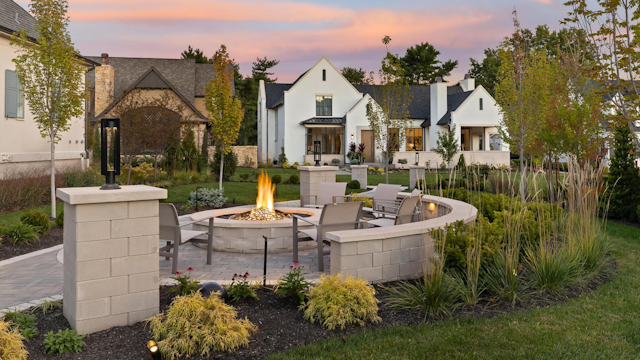This Discipline’s Importance Depends on a Synthesis of Economics, Science and Storytelling
By Katie Martinovic, Principal Landscape Architect / Vice President
Landscape architecture and design firms are in high demand. The market size for landscape architecture in the U.S. has steadily increased, and, according to the American Society of Landscape Architects, the economic value derived from its services has also risen significantly over the past two decades.
Architecture clients, including municipalities, developers and homeowners should recognize the quantitative data that reflects landscape architecture’s value:
- The return on investment (ROI) for home values that incorporate landscape architecture into their residential architecture and design projects can be as significant as 15 to 20 percent.
- Municipal projects that include landscape architecture are catalysts for adjacent economic development, with one study citing $2.10 in economic activity for every dollar spent on landscape architecture.
- The multifamily sector, which is largely dependent on landscape architects to provide outdoor amenities that define this housing option’s appeal, generated 19 percent of the U.S. gross domestic product in dollars.
- Similarly, the Lincoln Institute for Land Development cites the outsize economic contribution of mixed-use development, another market segment that is often dependent on thoughtfully designed outdoor spaces.
Indeed, landscape architecture has a desirable economic impact. Yet, landscape architecture is not, of course, defined purely by its ROI. Its scientific and social value for clients, neighborhoods, communities and the environment intersect with and extend far beyond numbers.
Economic development is intrinsically tied to other outcomes, including human welfare. Landscape architecture’s value also resides in its ability to solve our most pressing scientific challenges, as well as convey lasting narratives about the spaces where we live, work and play.
Landscape Architecture’s Scientific Value
In the summer of 2023, the U.S. Department of Homeland Security designated landscape architecture as a discipline within the science, technology, engineering and mathematics (STEM) field. This designation recognizes the critical role that landscape architects play, whether their market focus is residential or centered on designs to preserve ecosystems that border an urban core.
The American Society of Landscape Architects’ white paper, which was developed as part of their application materials to seek this designation, includes this poignant observation: “The profession applies cutting-edge materials and processes to improve the efficiency, functionality and health of our natural and built environments. Landscape architects engage in engineering-based design processes to protect the health, safety and welfare of the public and to create lasting value in the built environment.”
Whether a landscape architect is selecting plants that are germane to a local ecosystem for a residential architecture and design project, creating plans for environmentally conscious stormwater drainage or redesigning a city’s public spaces for accessibility, they are leveraging a persistent commitment to the sciences. However, it would be careless to exclude the value of the aesthetic gifts that landscape architects and designers bring to their craft; namely, the art of storytelling.
Landscape Architecture’s Value as Storytelling
The value of any architecture and design project creates a widening circle of opportunity for occupants or residents, the surrounding environment and the community in which it is situated. Economic and scientific challenges can be resolved with a landscape architecture and design firm’s ingenuity.
But landscape architecture also has a qualitative social impact. Decades before the inclusion of landscape architecture as a STEM discipline, Landscape Journal published research to provide a metric for landscape architecture’s societal value by surveying occupants on their feelings about design. Since that time, even more convincing literature on architecture’s social impact has emerged, including analyses of how architecture promotes empathy.
Architecture’s social impact is largely an extension of a timeless social behavior: storytelling. Storytelling’s utility is to teach, and yet its artistry is what leads us to understand. When a landscape architect executes their vision for a particular space, they tell the following stories:
- How landscape architecture sustains or departs from other architectural motifs.
- The built environment’s relationship to the natural world.
- A denotation of boundaries and pathways.
- An articulation of how the world beyond a space should be interpreted.
- In the case of commercial architecture, how a brand perceives its clients and how it desires to be perceived.
Each of these stories has implications that extend far beyond the immediate occupants. When one project communicates these stories, it is participating in a dialogue about what matters and what is valued.
The power of a landscape architect’s story is not only in the telling. In the ancient tradition of storytelling, listening is a part of the craft. The listener may be tasked with repeating the story to continue its existence or fulfilling the story by picking up where the previous storyteller left off. A landscape architect also is tasked with the art of listening, as they engage with clients and other stakeholders’ project vision.
For instance, in the residential architecture and design discipline, a successful collaboration that includes landscape architect and design firm depends on how early the landscape architect is brought into the project. An invitation to participate in a project’s vision from its inception onward has a powerful effect. A landscape architect can fulfill the client’s story by extending that story into the outdoors, the natural world and beyond.
In the multifamily architecture segment, landscape architects play a vital value-adding role by delivering what residents and property owners require. Multi-Housing News cites the modern resident’s desire for outdoor green space, opportunities for gathering and a focus on sustainability. These desirable amenities are clearly the purview of the landscape architect, and a defining characteristic of how multifamily buildings are designed today.
View this portfolio of residential, multifamily and commercial projects to appreciate the economic, scientific and social value that landscape architects create.








